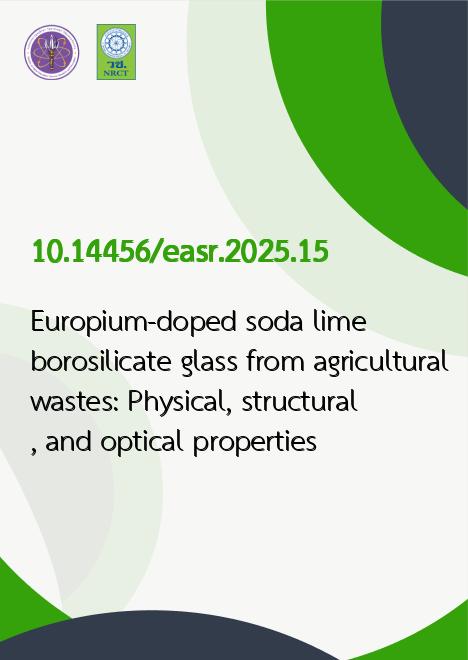
|
Europium-doped soda lime borosilicate glass from agricultural wastes: Physical, structural, and optical properties |
|---|---|
| รหัสดีโอไอ | |
| Creator | 1. Serifat O. Adeleye 2. Adekunle A. Adeleke 3. Petrus Nzerem 4. Adebayo I. Olosho 5. Esther N. Anosike-Francis 6. Waliyi A. Adeleke 7. Abdulkarim M. Hamza 8. Prabhu Paramasivam |
| Title | Europium-doped soda lime borosilicate glass from agricultural wastes: Physical, structural, and optical properties |
| Publisher | Faculty of Engineering, Khon Kaen University |
| Publication Year | 2568 |
| Journal Title | Engineering and Applied Science Research |
| Journal Vol. | 52 |
| Journal No. | 2 |
| Page no. | 174-187 |
| Keyword | Bio-silicate materials, Europium-doped, Borosilicate glass, Agricultural wastes, Melt-quenching technique |
| URL Website | https://ph01.tci-thaijo.org/index.php/easr/index |
| Website title | Engineering and Applied Science Research |
| ISSN | 2539-6161 |
| Abstract | Wheat husks and eggshells, while often regarded as waste, are available in millions of tons. Despite their status as by-products, these materials possess significant potential for various applications. Thus, this study explores the possibility of agricultural waste as a source of bio-silicate materials for glass production. Bio-silicate was extracted from leached wheat husks, and lime was obtained from eggshells. Europium-doped soda-lime borosilicate glasses were fabricated using the melt-quenching method having a chemical composition of 30Na2O-(40-x)B2O3-20SiO2-10CaO-xEu2O3 wherein x varied from 0.01 to 0.05 mol%. Chemical oxide compositions of wheat husk ash (88.64% SiO?) and calcined eggshell (91.30% CaO) were determined using X-ray fluorescence (XRF). Functional groups were confirmed by Fourier transform infrared (FTIR) spectroscopy. It was confirmed by X-ray diffraction (XRD) that the glasses were amorphous. The glasses exhibited 2.61 to 3.03 g/cm? densities and molar volumes of 10.91 to 14.37 cm?, increasing with higher europium doping levels, indicating a denser glass network. Optical features were characterised using Ultraviolet-visible (UV-Vis) spectroscopy, revealing direct band gaps ranging from 3.55 to 4.90 eV and indirect band gaps from 0.40 to 1.99 eV. Glasses doped with 0.05 mol fraction Eu?? showed the highest density, molar volume, and Urbach energy, suggesting suitability for UV-absorbing materials and high-energy photonic devices. Due to their unique emission properties under various excitation wavelengths and adaptable optical band gaps, the europium-doped borosilicate glasses derived from agricultural waste are useful in optical devices such as white LEDs. |
